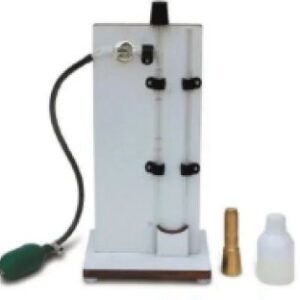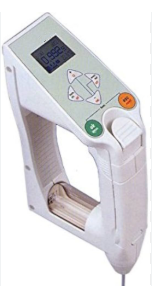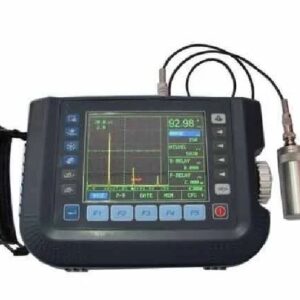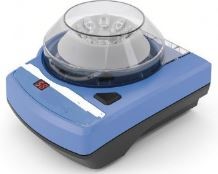UV SPECTROPHOTOMETER
Make Dinesh Scientific
DESCRIPTION
With a wavelength range of 190–1100 nm and a spectral bandwidth of 1 nm, the Microprocessor UV/VIS Spectrophotometer (Double Beam) 2 CELL HOLDER that is being offered has a working mode that is classified as Basic/Quantitative/Wavelength Scan/DNA Protein Test/Kinetics (T,A,C). A double beam (1200 lines/mm Grating) based optical system, three scanning speed options (Fast, Medium, and Slow), a photometric range of -4 to 4 Abs 0 to 220 %T, and wavelength accuracy of ±0.1 nm in U.V. range are further features of the system. Aside from wavelength reproducibility of less than ±0.1 nm, other standard features of the system include software CD, USB cable, and operation manual availability.
An advanced scientific tool for examining the properties of substances’ absorption in the ultraviolet region of the electromagnetic spectrum is a UV spectrophotometer. These devices, which operate in the 190–1100 nanometer wavelength range, use a monochromator and a light source—usually a stable deuterium lamp—to isolate particular UV light wavelengths. The sample is exposed to the light beam while housed in a quartz or glass cuvette inside the sample compartment. A detector—typically a photomultiplier tube or diode array—measures the transmitted or absorbed light. For improved accuracy, the spectrophotometer can be designed with a single beam or two beams, the latter of which compares the beams used for the sample and the reference. Temperature-controlled sample compartments and pathlength adjustment for advanced features
FEATURES:
WAVELENGTH RANGE:
- The ultraviolet region of the electromagnetic spectrum, which is normally between 190 and 1100 nanometers, is covered by UV spectrophotometers. Certain instruments may have longer ranges, extending into the visible and near-UV spectrums.
SINGLE OR DOUBLE BEAM DESIGN:
- UV spectrophotometers come in single or dual beam configurations. Because they compare the sample and reference beams, double beam instruments are more widely used and offer higher accuracy.
LIGHT SOURCE:
- For the UV spectrum, deuterium lamps are frequently used because they offer a steady and continuous light source. Additional light sources may be present in some instruments to provide a wider range of wavelengths.
MONOCHROMATOR:
- A monochromator is a device that selects a particular light wavelength. Monochromators with grating or prism bases are widely used and offer excellent wavelength selection flexibility and resolution.
DETECTOR:
- The intensity of transmitted or absorbed light is commonly measured using diode array detectors or photomultiplier tubes (PMTs).
SAMPLE COMPARTMENT:
- The cuvettes containing the sample and reference solutions are kept in the sample compartment. Multiple sample positions may be available on certain instruments for high-throughput analysis.
TECHNICAL DETAILS:
| MODEL | DS-SPM-1100 |
| Type | UV – Visible Spectrophotometer with True Double Beam |
| Wavelength Slew rate | Rapid wavelength slewing capability at 29000 nm/min |
| Wavelength setting | Can be adjusted in 0.1 nm increments |
| Wavelength range | Covers wavelengths from 190 to 1100 nm |
| Scan speed | Variable scan speed ranging from 3000 to 2 nm/min |
| Spectral bandwidth | Spectral bandwidth is set to 1 nm (190-1100 nm) |
| Light source change | Automatic light source interchange with precision of 0.1 nm increments |
| Stray light | Minimal stray light 0.02% |
| Detector | Features Silicon photodiode / PMT (Photomultiplier tubes) |
| Wavelength accuracy | High accuracy of ± 0.1 nm in UV range or better and 0.3 nm in visible range |
| Light source | Equipped with Halogen, Tungsten & Deuterium Lamp with automatic changeover |
| Wavelength repeatability | Provides precise wavelength repeatability of ±0.1 nm |
| Noise | Low noise levels of 0.00005 Abs |
| Photometric range | · Absorbance: -4 to 4 Abs and
· Transmittance: 0.0 to 400% |
| Photometric accuracy | Offers excellent photometric accuracy of ±0.004 Abs (at 1.0 Abs) and ±0.002 Abs (at 0.5 Abs) |
| Compatibility and Output | Can be used standalone, with Computer, Printer, and USB drive |
| Drift | Drift is minimal at ±0.0004 Abs/h |
| Baseline flatness | Maintains baseline flatness within ±0.0006 Abs |
| Photometric repeatability | Ensures high photometric repeatability, ±0.0002 Abs (at 1.0 Abs) |
| Standard Software | Comes with standard software including Photometric, Spectrum, Quantitation, Kinetics, Time scan, and multi-component quantitation functionalities |
| Photometric system | Utilizes a Blazed holographic grating in Czerny-Turner mounting with 1200 lines/mm |
| PC Configuration | · PC with 13th Generation, i9 processor, 24” TFT Screen, 1 TB SSD Hard drive, 2 TB SATA HDD Hard drive, 64 GB RAM, original Windows, and Single user antivirus
· Workstation for instrument installation provided |
| Printer | All-in-one Color Laser Printer, Scanner, and Photocopier with print speed of 21-30 page/min, supporting Duplex Printing, Wi-Fi, Bluetooth, and USB connectivity
|
| Online UPS | 10 KVA capacity with 1 hour backup |
| Inverter AC | 2 tons, 5 Star Rating, Split) for maintaining ambient temperature |















Reviews
There are no reviews yet.